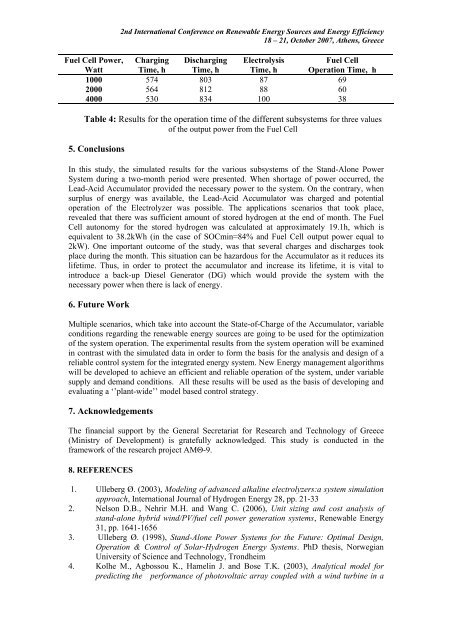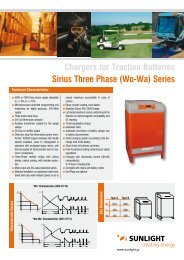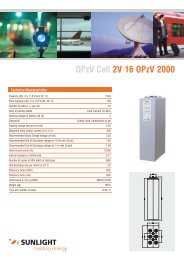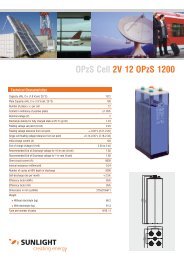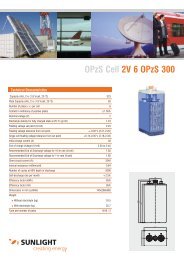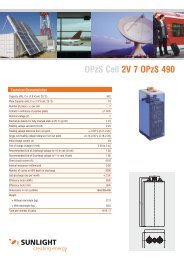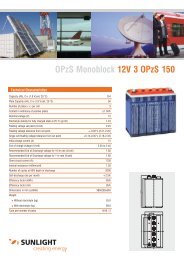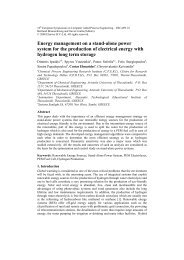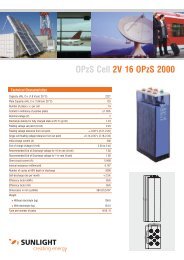analysis and modeling of a stand-alone power system for the ...
analysis and modeling of a stand-alone power system for the ...
analysis and modeling of a stand-alone power system for the ...
Create successful ePaper yourself
Turn your PDF publications into a flip-book with our unique Google optimized e-Paper software.
Fuel Cell Power,<br />
Watt<br />
2nd International Conference on Renewable Energy Sources <strong>and</strong> Energy Efficiency<br />
18 – 21, October 2007, A<strong>the</strong>ns, Greece<br />
Charging<br />
Time, h<br />
Discharging<br />
Time, h<br />
Electrolysis<br />
Time, h<br />
1000 574 803 87 69<br />
2000 564 812 88 60<br />
4000 530 834 100 38<br />
Fuel Cell<br />
Operation Time, h<br />
Table 4: Results <strong>for</strong> <strong>the</strong> operation time <strong>of</strong> <strong>the</strong> different sub<strong>system</strong>s <strong>for</strong> three values<br />
<strong>of</strong> <strong>the</strong> output <strong>power</strong> from <strong>the</strong> Fuel Cell<br />
5. Conclusions<br />
In this study, <strong>the</strong> simulated results <strong>for</strong> <strong>the</strong> various sub<strong>system</strong>s <strong>of</strong> <strong>the</strong> St<strong>and</strong>-Alone Power<br />
System during a two-month period were presented. When shortage <strong>of</strong> <strong>power</strong> occurred, <strong>the</strong><br />
Lead-Acid Accumulator provided <strong>the</strong> necessary <strong>power</strong> to <strong>the</strong> <strong>system</strong>. On <strong>the</strong> contrary, when<br />
surplus <strong>of</strong> energy was available, <strong>the</strong> Lead-Acid Accumulator was charged <strong>and</strong> potential<br />
operation <strong>of</strong> <strong>the</strong> Electrolyzer was possible. The applications scenarios that took place,<br />
revealed that <strong>the</strong>re was sufficient amount <strong>of</strong> stored hydrogen at <strong>the</strong> end <strong>of</strong> month. The Fuel<br />
Cell autonomy <strong>for</strong> <strong>the</strong> stored hydrogen was calculated at approximately 19.1h, which is<br />
equivalent to 38.2kWh (in <strong>the</strong> case <strong>of</strong> SOCmin=84% <strong>and</strong> Fuel Cell output <strong>power</strong> equal to<br />
2kW). One important outcome <strong>of</strong> <strong>the</strong> study, was that several charges <strong>and</strong> discharges took<br />
place during <strong>the</strong> month. This situation can be hazardous <strong>for</strong> <strong>the</strong> Accumulator as it reduces its<br />
lifetime. Thus, in order to protect <strong>the</strong> accumulator <strong>and</strong> increase its lifetime, it is vital to<br />
introduce a back-up Diesel Generator (DG) which would provide <strong>the</strong> <strong>system</strong> with <strong>the</strong><br />
necessary <strong>power</strong> when <strong>the</strong>re is lack <strong>of</strong> energy.<br />
6. Future Work<br />
Multiple scenarios, which take into account <strong>the</strong> State-<strong>of</strong>-Charge <strong>of</strong> <strong>the</strong> Accumulator, variable<br />
conditions regarding <strong>the</strong> renewable energy sources are going to be used <strong>for</strong> <strong>the</strong> optimization<br />
<strong>of</strong> <strong>the</strong> <strong>system</strong> operation. The experimental results from <strong>the</strong> <strong>system</strong> operation will be examined<br />
in contrast with <strong>the</strong> simulated data in order to <strong>for</strong>m <strong>the</strong> basis <strong>for</strong> <strong>the</strong> <strong>analysis</strong> <strong>and</strong> design <strong>of</strong> a<br />
reliable control <strong>system</strong> <strong>for</strong> <strong>the</strong> integrated energy <strong>system</strong>. New Energy management algorithms<br />
will be developed to achieve an efficient <strong>and</strong> reliable operation <strong>of</strong> <strong>the</strong> <strong>system</strong>, under variable<br />
supply <strong>and</strong> dem<strong>and</strong> conditions. All <strong>the</strong>se results will be used as <strong>the</strong> basis <strong>of</strong> developing <strong>and</strong><br />
evaluating a ‘’plant-wide’’ model based control strategy.<br />
7. Acknowledgements<br />
The financial support by <strong>the</strong> General Secretariat <strong>for</strong> Research <strong>and</strong> Technology <strong>of</strong> Greece<br />
(Ministry <strong>of</strong> Development) is gratefully acknowledged. This study is conducted in <strong>the</strong><br />
framework <strong>of</strong> <strong>the</strong> research project ΑΜΘ-9.<br />
8. REFERENCES<br />
1. Ulleberg Ø. (2003), Modeling <strong>of</strong> advanced alkaline electrolyzers:a <strong>system</strong> simulation<br />
approach, International Journal <strong>of</strong> Hydrogen Energy 28, pp. 21-33<br />
2. Nelson D.B., Nehrir M.H. <strong>and</strong> Wang C. (2006), Unit sizing <strong>and</strong> cost <strong>analysis</strong> <strong>of</strong><br />
st<strong>and</strong>-<strong>alone</strong> hybrid wind/PV/fuel cell <strong>power</strong> generation <strong>system</strong>s, Renewable Energy<br />
31, pp. 1641-1656<br />
3. Ulleberg Ø. (1998), St<strong>and</strong>-Alone Power Systems <strong>for</strong> <strong>the</strong> Future: Optimal Design,<br />
Operation & Control <strong>of</strong> Solar-Hydrogen Energy Systems. PhD <strong>the</strong>sis, Norwegian<br />
University <strong>of</strong> Science <strong>and</strong> Technology, Trondheim<br />
4. Kolhe M., Agbossou K., Hamelin J. <strong>and</strong> Bose T.K. (2003), Analytical model <strong>for</strong><br />
predicting <strong>the</strong> per<strong>for</strong>mance <strong>of</strong> photovoltaic array coupled with a wind turbine in a


